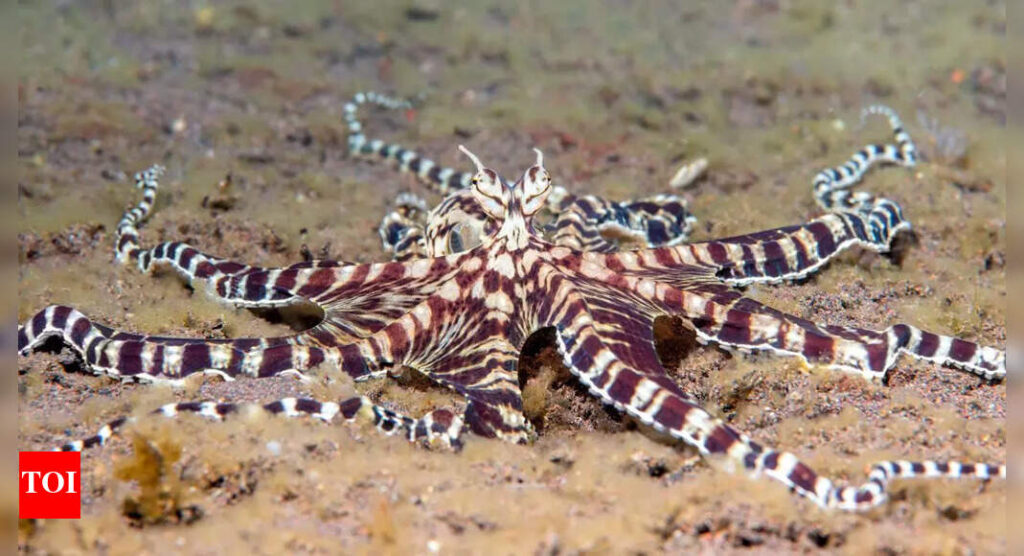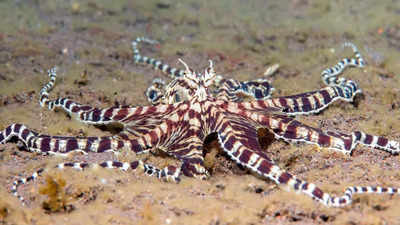Mimic Octopus: Discover the sea creature that live a ‘life of lies’ with its unique survival strategies |

Deep under the sea, a real-life master of disguise lies in wait — take a look at the Mimic Octopus (Thaumoctopus mimicus), nature’s ultimate chameleon. It can change shape to resemble many sea creatures, some harmless but others perilously misleading.
First found off the shores of Indonesia, the Mimic Octopus has a remarkable talent not only to change colour to blend in with the ocean floor but also to mimic the forms, habits, and even the movements of other sea animals. It can mimic the lionfish, its venomous spines erect, or take on the form of a flatfish, making itself into a pancake on the ocean floor to remain concealed. Most surprisingly, it can mimic the sea snake, one of the sea’s most formidable predators, to deter perceived danger.
Mimic Octopus discovered in Indonesian waters
Found by researchers in 1998 off the coastal waters of Indonesia, close to Sulawesi, the Mimic Octopus impressed researchers with its unparalleled skill to camouflage. Regular octopuses also change colour and texture to camouflage, but it does a lot more. It really alters body shape, changes posture and alters method of locomotion to impersonate its vastly different sea creatures.
This skill allows the Mimic Octopus not only to camouflage itself, but also to impersonate another species. — something uncommon in the animal kingdom, especially among invertebrates.
Mimic Octopus survival strategy
The key to the Mimic Octopus’s survival strategy lies in the ability to mimic. When threatened, the octopus does not strike with brute power or velocity. Instead, it prefers to mimic which sea animal, depending on the specific threat it faces.
For example, when it is threatened by possible predators, it can transform its body shape and extend its arms in a way that is a duplicate of the lionfish, a toxic fish that the majority of predators will not touch. At others, it is able to bend its arms, pull its head in, and wave its remaining arms to successfully replicate the slithering pattern of a sea snake — a predator to be fled from along the reef.
One of the most subtle but effective changes is when it resembles a flatfish. Folding against the sea bed and gliding silently along the seafloor, the octopus becomes almost invisible, with the ability to slide away undetected or lie in wait to ambush prey. One of the most impressive feats of the Mimic Octopus, perhaps, is when it imitates a flatfish. Both visual and behavioral mimicry are required in this instance as the octopus flattens itself, patterns its body to match the sand-covered seafloor, and moves along with an almost undetectable side-to-side motion imitating a live flatfish.
This particular mimicry serves two functions, allowing the octopus both to evade predators and establish ambushes on unwary passing prey while still concealed in plain sight.
Mimic Octopus and the power of deceptive hunting
Although disguises of this kind are beneficial in defense, the Mimic Octopus employs mimicry to be a good hunter for itself. By mimicking the form and appearance of poisonous or aggressive species, it is able to approach unsuspecting prey without inducing defensive behavior.
Most sea creatures have a natural aversion to creatures such as lionfish or sea snakes, regarding their presence as an omen. The Mimic Octopus employs this natural tendency to close in on its prey in order to deliver a quick and precise attack. This shows that the mimicry of the octopus is not merely passive but actively utilized to dominate other organisms within its habitat.
Mimic Octopus: The art of survival by strategy
Mimic Octopus is a living testament to evolution’s power to generate survival strategies beyond brute force. Its behavior shows not only an incredibly high level of bodily agility but also an environmental evaluation ability and decision-making ability.
While all the rest of the creatures of the ocean rely on instincts alone for response, the Mimic Octopus appears to gaze around, calculate risk, and select disguise. Such instant easiness to morphing proves psychic facility unmatched by invertebrates. In the great drama of life in the ocean, the Mimic Octopus has its role. It is the witness to the law of evolution that survival is mostly by guile, not power. By imitating other animals to perfection, this octopus has earned the reputation of being the greatest master of evading predators and the art of hunting prey, demonstrating the unimaginable ingenuity of nature.
Its existence reminds that the sea, as life itself, is unpredictable — and sometimes, it is the lowest of beings that will most likely redefine the rules of life in the sea.
Also Read | How do snakes see? Discover the fascinating truth behind their vision






